The Berlin Wall
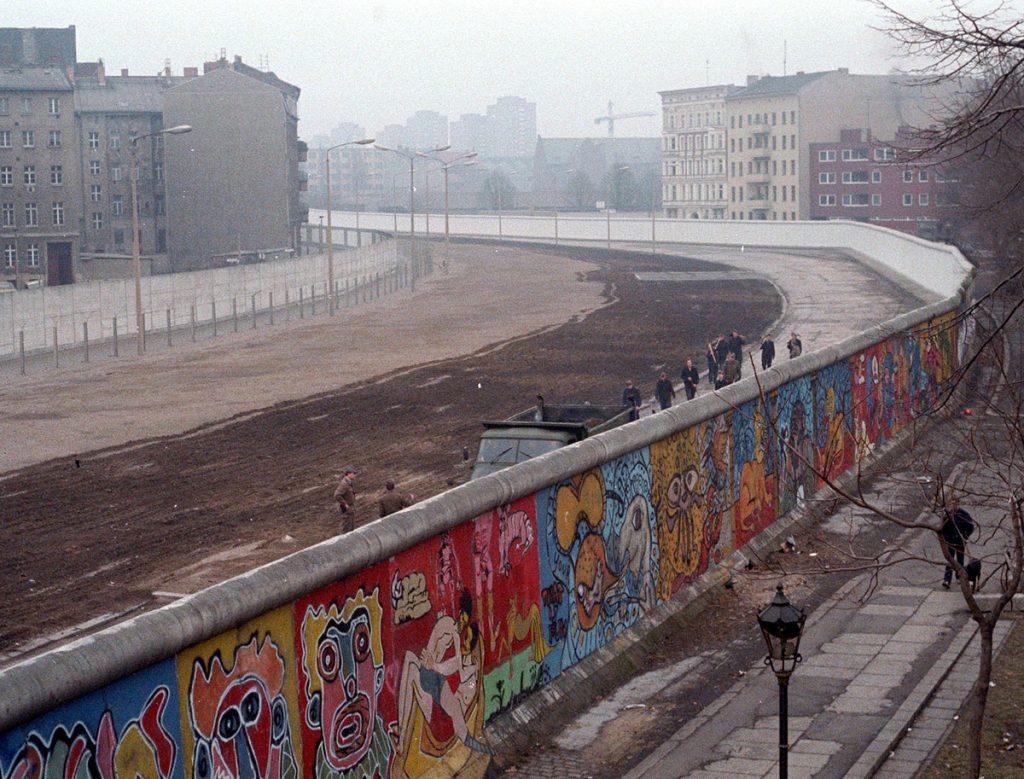
Thierry Noir and The Berlin Wall
The Berlin Wall is perhaps the most famous human artefact in modern world history. Built in 1961 at the height of the Cold War, the Wall symbolised in physical form the ideological and political divide between the Western Bloc and the USSR. 15 years after Winston Churchill’s Iron Curtain speech in Fulton, Missouri, a monolithic and impenetrable barrier that cut across Europe became a reality, situating the city of Berlin at the fulcrum of Cold War antagonisms.
In 1984,Thierry Noir became the first artist to illegally paint miles of the Berlin Wall. This revolutionary act inspired other artists, and over the next five years the Wall was covered with layers of artwork and images, creating a ‘palimpsest of protest’. As Noir says, painting the Wall made him feel stronger than it. For years, the Wall had stood as an oppressive symbol of a divided world, materialising a history of separation and struggle. Noir’s work subverted this iconic symbol of war into a symbol of hope, granting it a real human significance.
The extracts below include Noir’s personal recollections of his experiences painting the Berlin Wall in the 1980s and beyond.

Portrait
“This photo was taken in 1986 along Bethaniendamm in Berlin-Kreuzberg. It was taken by my first wife Gabi Noir. I was wearing a suit that day that I had found in a bag of old clothes on the street. At that time West Berliners often left furnishings and clothes on the streets. It was a recycling process. During this period I would paint the Wall all day and then travel to the centre of West Berlin to sell canvases in restaurants. That is how I survived back then.” – Thierry Noir
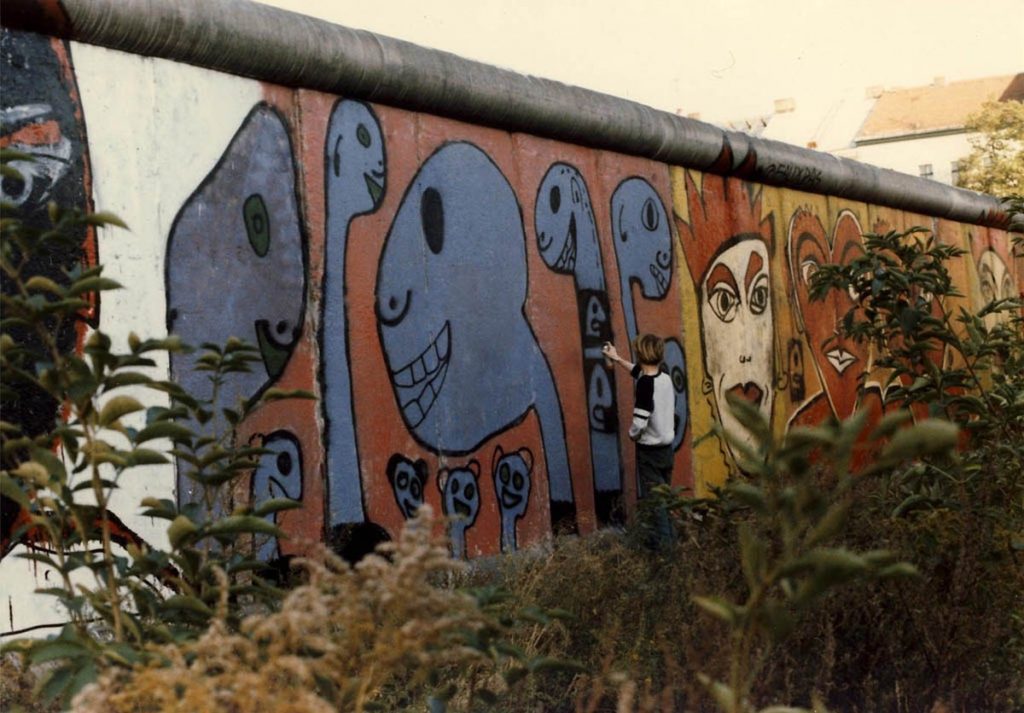
Painting the Berlin Wall
“This is me painting in 1985 the Wall along Waldemarstrasse in Berlin-Kreuzberg. I was painting these dinosaurs to represent a sort of mutation of nature because of the Berlin wall and the wall painting I created were like a mutation of the culture. Where else to find kilometres of painted concrete wall in Europe other than in West Berlin? I used to paint the Berlin Wall every day. That was how all the ideas came to me: not down from the sky, not from the head to the hand but from the hand to the head. From the beginning, with Christophe Bouchet, we used to collect left over paint and materials from the the renovation of the houses in Kreuzberg, for the 750th Anniversary of Berlin in 1987. We made do with whatever we could find on the streets as we had no money to buy materials.” – Thierry Noir
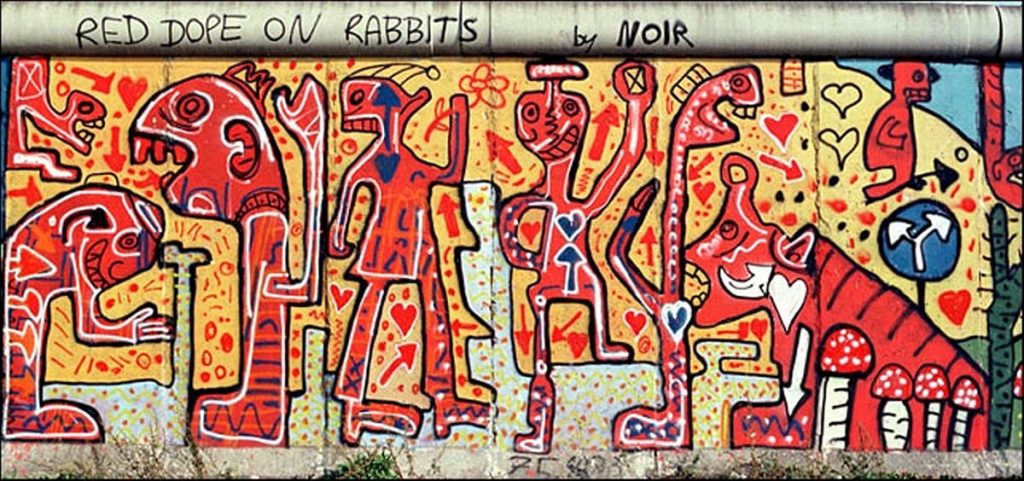
Red Dope on Rabbits
“I painted this at Potsdamer Platz in August 1985. It was dedicated to the thousands of wild rabbits that used to live on the huge Death Strip between the two walls around Potsdamer Platz. Those rabbits were a mutation of nature. Where else would you see so many rabbits running around freely in the middle of a big city? The only place was in divided Berlin Similarly, my paintings on the Berlin Wall were a mutation of culture. Where else would you find kilometre upon kilometre of continuously painted wall in the middle of a capital city other than in divided Berlin. Bartek Konopka later made an Oscar-nominated documentary about the wild rabbits of Berlin entitled Rabbit à la Berlin using the story of the death Strip rabbits as an allegory for the recent social history of Eastern Europe and its people.” – Thierry Noir

Work Brothers
“This painting is called “The Gebrüder Arbeit (The Work Brothers)”. It is a homage to the hard toil of painting the Berlin Wall every day. I created this work as a way of answering the questions of passers-by. Unbelievably, people would sometimes think that I was a spy from France in the employ of the Berlin authorities to make to wall beautiful. I would tell people that I was not trying to make the Wall beautiful because in fact that was absolutely impossible. 136 persons were killed trying to get across into West Berlin. No matter how many kilograms of paint that I covered the wall with, that fact remains the same.” – Thierry Noir

Statues of Liberty
“It was the 100th anniversary of the Statue of Liberty in N.Y.C. so I found some spray cans and with Christophe Bouchet made a two metre high stencil. It was made from a plastic napkin fixed on a wooden frame. On the 4th of July, we put up 42 Statues of Liberty on the Wall at Checkpoint Charlie. It was well guarded and dangerous to paint here. We did not have enough money for more spray paint to finish the entire project and paint more the next day. As David Bowie said in his 1982 song Heroes: ”You can be heroes, just for one day”.” – Thierry Noir

Making friends with Keith Haring
“On 23rd October 1986, three months after I had painted the Statues of Liberty, I heard on the radio that Keith Haring was in Berlin to paint the Wall at Checkpoint Charlie. I went there and I saw that my statues were all gone, painted over by a huge amount of yellow paint. I talked with Keith about this and he was embarrassed and apologised to me. He said that: “in New York you can get killed for that”. He was invited over for just a couple of days and the section of Wall had been preprepared for him with a yellow base that went over the Statues that I had painted. The yellow colour was very transparent so it was possible to see my Statues through it. I was angry but it was not his fault. Keith was a great guy and a great artist.” – Thierry Noir

Wim Wenders Wall Pieces
“This photo was taken in 1986 along the Waldemarstrasse in Kreurzberg. It shows my paintings and the paintings of Kiddy Citny. There were featured in the Wim Wenders film The Wings of Desire. Wim Wenders came back to Germany in 1985 after his success with the 1984 ‘Paris, Texas’. Wenders wanted to make a film in Berlin about angels. I met wit him every two or three days in a nearby restaurant called Meeting Points Restaurant where I used to sell small paintings. Wenders was a patron there. In the beginning of 1987 he decided to start the shoot of “The Wings of Desire” and this part of the Wall along the Waldemarstrasse in Berlin Kreuzberg was an important location for the film. In the film you can see my works and me painting the Wall on a ladder. If you pause the film at this point you will see that part of the wall in front of me.” – Thierry Noir

Wings Of Desire
“Here is a famous scene from Wings of Desire in which Bruno Ganz, an Angel sees colour for the first time. On the day of filming, 17th February 1987, it was minus 13 degress. The scene, which I was also in, was repeated eight times until the director Wim Wenders was satisfied with it. Bruno Ganz would always be in the caravan waiting for the next take. A couple of day before I had painted all the big heads you can see behind in the film. It was just too cold to stop so I would paint for hours each day without a break.” – Thierry Noir

Elephant Key
“This elephant was one of the earliest paintings that I made on the Berlin Wall. I began to paint outside because I wanted to say that it is good to put art in the streets and not solely in museums and galleries. At the time my influences were taken from many directions. By the Painters: Pablo Picasso, Joan Miro, Fernand Leger, Edouard Manet, Claude Monet, Gaston Chaissac, Jean Dubuffet, Alberto Giacometti. By the musicians: David Bowie, Iggy Pop, Lou Reed, Kraftwerk, Led Zeppelin and Nina Hagen. This painting represented for me the key to success – heavy work every day. If you wait at home for inspiration, you can wait very long” – Thierry Noir

Homage To Duchamp
“This piece was a homage to Marcel Duchamp’s 1917 New York exhibition and the enormous scandal provoked by him in exhibiting a urinal. I put this piece up in April 1984, shortly after starting to paint the Wall. A few days later I also displayed a hand basin.” – Thierry Noir

Checkpoint Charlie
“It was a unique experience to live in West Berlin in the 1980s surrounded by a wall and in the middle of the GDR. West-Berlin had a special status, because its administration was formally conducted by the Western Allies and there was of course a strong military presence. There was a also strong cultural scene in the city. West Berlin was the centre of the New Wave movement and everybody I met when I came from France in January 1982 seemed to be an artist. A little like when I came to Shoreditch, East London in 2013. It was also intriguing to see the American GI’s with a big ghetto blaster on their shoulders, listening to Grand Master Flash or Sugar Hill Gang near the US military base.” – Thierry Noir

Berlin Wall Graffiti
“This was a protest against the Population Census Boycott. Most of the citizens of Kreuzberg were against the population census of 1985 and the repetition of the heads makes the message stronger. That is why the person painted it there in the middle of my painting. I was very upset when I saw that in 30 seconds one stupid guy put his name just in the middle of the painting I made in three hours. Then I thought. What shall I do? Shall I sleep in front of the wall? Shall I call the police? In the end I just decided to repair the painting as quick as it was destroyed and this is what I continued to do.” – Thierry Noir

Painting in the Death Strip
“Here I am painting on the other side of the Berlin Wall in the Death Strip. The photo was taken by the Associated Press photographer, Hans-Jörg Krauss, who was a war photographer. It was taken while the Wall was falling down and people had hammered heavily on the wall, making holes in it. These holes were so big in some spots such as near to Checkpoint Charlie or the Reichstag, that it was possible to pass through the holes and paint the other side of the wall. It was great to paint this side after so many years of fear and harassment by the border guards. With only a spray can or two, I would play cat and mouse for hours with the soldiers. To paint a lot of big heads, one after the other, very quick. I would always jump back through the hole into West Berlin territory before the border guards could reach me.” – Thierry Noir

The Berlin Wall Fallen
In 1989, the Wall fell, marking the end of the Cold War.
“This is a so called Wall Graveyard in 1990 in Berlin Kreuzberg. A pile of blocks from the remnants of the Berlin Wall. These were put into special machines which ground them down and separated the metal bars and the concrete in order to reduce it all down to tons of granulates, perfect to build new roads in the former GDR.” – Thierry Noir

The East Side Gallery
Sections of the Wall, such as those at Potsdamer Platz, on Bernauer Strasse and on Muhlenstrass were deliberately left as a lasting memorial: the East Side Gallery which is approximately 1,3 km in length. Many artists, including Noir, were invited to paint the Eastern face of these Wall fragments as a visual enactment of reunification.
“The East Side Gallery is located along the river, which crosses Berlin, The Spree. The river itself belonged to East Berlin. The GDR, which was not able to place the wall on the west shore of the river, asked the soldiers to build only one wall but withdrawal the east shore. The guards of the border, to replace the no man’s land, made instead patrols with grey speedboats on the river, 24 hours a day, going very near to the edge of the shore, to show the enemies where the border is.” – Thierry Noir

Sotheby’s sell salvaged Berlin Wall segments in Monaco (1990)
“Here you can see Madame Rizolli with a piece of Berlin Wall that I painted. It was purchased at an Auction in Monaco on the 23rd of June 1990. Soldiers from the GDR came to remove the old Wall pieces one day and they were taken to Monaco to be sold. In total my pieces of wall sold for $1.5 million and I received none of the money. To this day it is still strange to see one of my Wall pieces inside a private house in the South of France. This particular piece was made by me in 1985 in the Waldemarstrasse. When I painted the Wall I never thought about money, I painted the Wall as a protest and because I had to do it.” – Thierry Noir
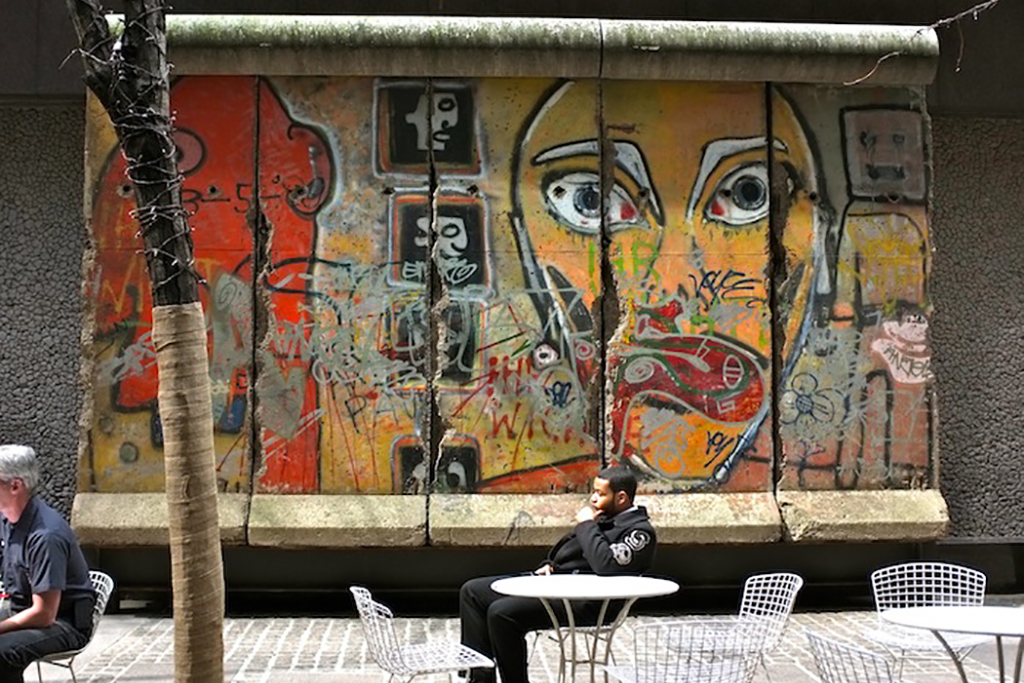
520 Madison Avenue, New York City
Many segments of Berlin Wall were auctioned by Sotheby’s at the 1990 Monaco sale including the iconic stretch of Berlin Wall featured in Wings of Desire.
“These 5 sections of the wall are now in a private courtyard at 520 Madison Avenue in NYC and the ladder I was using is in the permanent collection of the Wende Museum in the USA. What a destiny!” – Thierry Noir
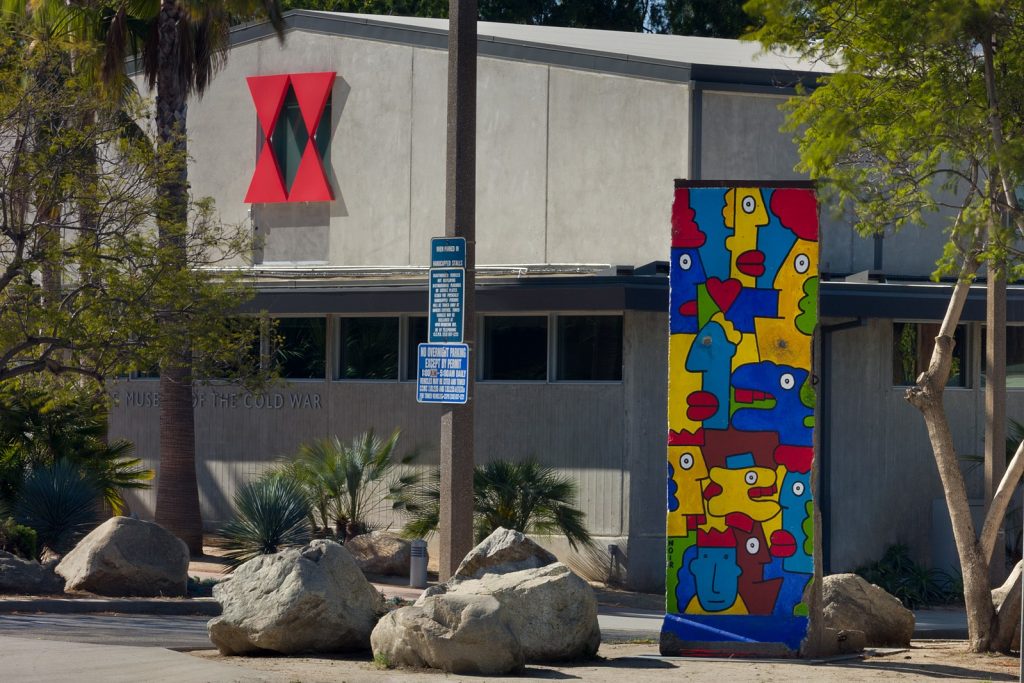
Commissioned Berlin Wall segments
Years on from the fall of the Berlin Wall the historical significance of Noir’s ‘one real revolutionary’ act to paint the Wall has been evaluated by scholars and institutions around the World. Many institutions have commissioned Noir to paint Berlin Wall sections as a testament to the current freedoms we enjoy in the world today. This piece was commissioned in 2005 by the The Wende Museum of the Cold War in Los Angeles, USA.

Thierry Noir Berlin Wall segment at the United Nations
“This image was taken at Leipzigerplatz (near Potsdamer Platz) in July 2001. Here you can see the Mayor of Berlin Klaus Wowereit, the President of the German Parliament, Wolfgang Thierse and UN Secretary-General Kofi Annan. Kofi Annan came to Germany to collect three pieces of the Berlin Wall to put in the garden of the UN Headquarters in New York.” – Thierry Noir
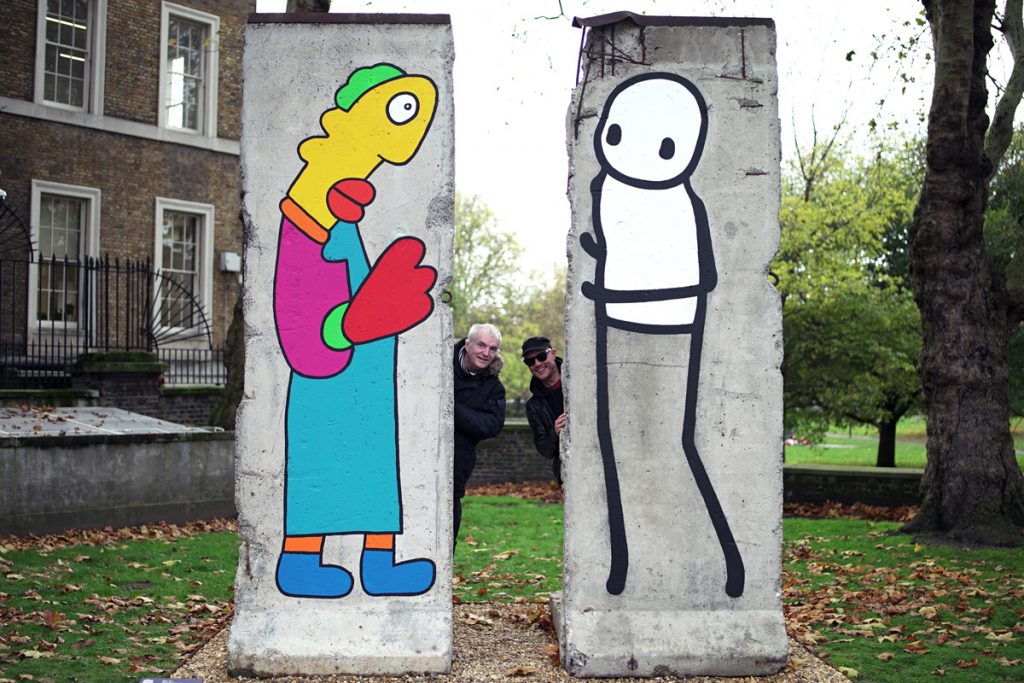
Thierry Noir and STIK commissioned by Imperial War Museum London
In 2019 Imperial War Museum London commissioned Noir and UK based artist, and long time Noir collaborator, STIK to paint two original Berlin Wall segments to commemorate the 30th Anniversary of the fall of the Berlin Wall, 1989 to 2019.